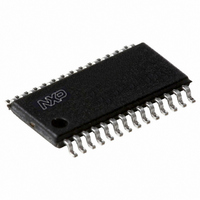SC16IS752IPW,112 NXP Semiconductors, SC16IS752IPW,112 Datasheet - Page 22

SC16IS752IPW,112
Manufacturer Part Number
SC16IS752IPW,112
Description
IC UART DUAL 12C/SPI 28TSSOP
Manufacturer
NXP Semiconductors
Type
IrDA or RS- 232 or RS- 485r
Datasheet
1.SC16IS752IBS151.pdf
(59 pages)
Specifications of SC16IS752IPW,112
Number Of Channels
2, DUART
Package / Case
28-TSSOP (0.173", 4.40mm Width)
Features
Low Current
Fifo's
64 Byte
Protocol
RS232, RS485
Voltage - Supply
2.5V, 3.3V
With Auto Flow Control
Yes
With Irda Encoder/decoder
Yes
With False Start Bit Detection
Yes
With Modem Control
Yes
Mounting Type
Surface Mount
Data Rate
5 Mbps
Supply Voltage (max)
3.6 V
Supply Voltage (min)
2.3 V
Supply Current
6 mA
Maximum Operating Temperature
+ 95 C
Minimum Operating Temperature
- 40 C
Mounting Style
SMD/SMT
Operating Supply Voltage
2.5 V or 3.3 V
Lead Free Status / RoHS Status
Lead free / RoHS Compliant
For Use With
568-4000 - DEMO BOARD SPI/I2C TO DUAL UART568-3510 - DEMO BOARD SPI/I2C TO UART
Lead Free Status / Rohs Status
Lead free / RoHS Compliant
Other names
568-4016-5
935279292112
SC16IS752IPW
SC16IS752IPW
935279292112
SC16IS752IPW
SC16IS752IPW
NXP Semiconductors
SC16IS752_SC16IS762_7
Product data sheet
8.1 Receive Holding Register (RHR)
8.2 Transmit Holding Register (THR)
8.3 Interrupt Enable Register (IER)
The receiver section consists of the Receive Holding Register (RHR) and the Receive
Shift Register (RSR). The RHR is actually a 64-byte FIFO. The RSR receives serial data
from the RX terminal. The data is converted to parallel data and moved to the RHR. The
receiver section is controlled by the Line Control Register. If the FIFO is disabled, location
zero of the FIFO is used to store the characters.
The transmitter section consists of the Transmit Holding Register (THR) and the Transmit
Shift Register (TSR). The THR is actually a 64-byte FIFO. The THR receives data and
shifts it into the TSR, where it is converted to serial data and moved out on the TX
terminal. If the FIFO is disabled, location zero of the FIFO is used to store the byte.
Characters are lost if overflow occurs.
The Interrupt Enable Register (IER) enables each of the six types of interrupt, receiver
error, RHR interrupt, THR interrupt, Modem Status, Xoff received, or CTS/RTS change of
state from LOW to HIGH. The IRQ output signal is activated in response to interrupt
generation.
Table 11.
Bit
7
6
5
4
3
2
Symbol
IER[7]
IER[6]
IER[5]
IER[4]
IER[3]
IER[2]
Interrupt Enable Register bits description
Table 11
[1]
[1]
[1]
[1]
Description
CTS interrupt enable.
RTS interrupt enable.
Xoff interrupt.
Sleep mode.
Modem Status interrupt.
Remark: See IOControl register bit 1 or bit 2 (in
of how to program the pins as modem pins.
Receive Line Status interrupt.
shows Interrupt Enable Register bit settings.
logic 0 = disable the CTS interrupt (normal default condition)
logic 1 = enable the CTS interrupt
logic 0 = disable the RTS interrupt (normal default condition)
logic 1 = enable the RTS interrupt
logic 0 = disable the Xoff interrupt (normal default condition)
logic 1 = enable the Xoff interrupt
logic 0 = disable Sleep mode (normal default condition)
logic 1 = enable Sleep mode. See
logic 0 = disable the Modem Status Register interrupt (normal default
condition)
logic 1 = enable the Modem Status Register interrupt
logic 0 = disable the receiver line status interrupt (normal default condition)
logic 1 = enable the receiver line status interrupt
Dual UART with I
Rev. 07 — 19 May 2008
2
SC16IS752/SC16IS762
C-bus/SPI interface, 64-byte FIFOs, IrDA SIR
Section 7.6 “Sleep mode”
Table
29) for the description
© NXP B.V. 2008. All rights reserved.
for details.
22 of 59















